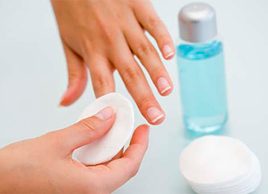Are nail polish removers bad for your health?
Find out if you should be avoiding the chemicals in your nail polish remover

Source: Best Health Magazine, September 2009; Photo courtesy JupiterImages
When you twist the lid off a bottle of nail polish remover, a sharp-smelling odour fills the air. It makes you wonder: Should I really be using this stuff? Is it dangerous? Fortunately, it’s not. ‘Polish removers have been used since the 1930s with very few problems,’ says Doug Schoon, president of Schoon Scientific, a California company that specializes in scientific and regulatory issues in the cosmetics industry.
What nail polish removers are made of
While people have been colouring their nails since as far back as 3000 BC, using the pigment of plants and flowers, polish itself’and removers’were an offshoot of the invention of automotive paint in the 1920s. Today’s removers are made up mainly of a solvent‘needed to dissolve the resins in polish’such as acetone, methyl acetate or methyl ethyl ketone. These chemicals have numerous other uses; you can find them in paint thinners, glue, dry-erase markers and nail polish itself. All three are permitted in cosmetics in Canada, the United States and the European Union. Of the three, acetone is used most frequently in polish removers.
Is "acetone-free" a good thing?
About 15 years ago, scientists formulated new solvents, and began marketing removers labelled ‘non-acetone,’ which made some people think acetone was toxic. But acetone is present in the human body (a product of fat breakdown) and has been mass-produced by scientists for nearly 100 years. ‘There’s no scientific basis to say acetone is more dangerous than the alternative solvents,’ says Paul Bryson, director of research and development for OPI Products, the world’s largest manufacturer of professional nail products. ‘Acetone is one of the safest solvents other than water.’
In an assessment of acetone, the Environmental Protection Agency (a U.S. government agency responsible for environmental laws and research) reports that both a 17-month-old and a 53-year-old who accidentally ingested the solvent were sick for a short time, but later made full recoveries. (However, a study found that rats fed very high concentrations for 13 weeks eventually developed kidney damage.)
What about the other solvents?
Other common solvents raise different concerns. Methyl acetate, for example, is more dangerous than acetone if it is accidentally ingested’so manufacturers who use it make the nail polish remover bitter tasting. As for methyl ethyl ketone, it works slowly on nail polish, so you will have to put up with its very strong smell for longer. Also, as other volatile organic compounds do, it contributes to smog formation; California has limited the amount of this solvent in consumer products for this reason.
If regular removers still worry you, you can try an eco-friendly version such as Suncoat Natural Nail Polish Remover. This Canadian product is made from soy and corn oil, but it takes longer to work.
Nail polish remover safety
All of the solvents used in regular removers are flammable, so keep them away from heat. As well, they can have a drying effect, says Doug Atkinson, executive trainer and spokesperson for Coty Beauty Colour Cosmetics (which includes Sally Hansen nail care products), so most nail polish removers contain moisturizing ingredients such as vitamin E, grape seed, lavender or tea tree oil. Applying cuticle cream or oil after removing polish can help very dry nails.
To remove polish with maximum efficiency, moisten a cotton pad with remover and hold the pad down on the nail for a few seconds so the product can soak in; then wipe (away from the cuticle).
And while removers are safe, they are, like nail polish, smelly. So crack open a window or put on the bathroom fan during your next home manicure.
This article was originally titled "The Truth About Nail Polish Removers," in the September 2009 issue of Best Health. Subscribe today to get the full Best Health experience’and never miss an issue!’and make sure to check out what’s new in the latest issue of Best Health.




